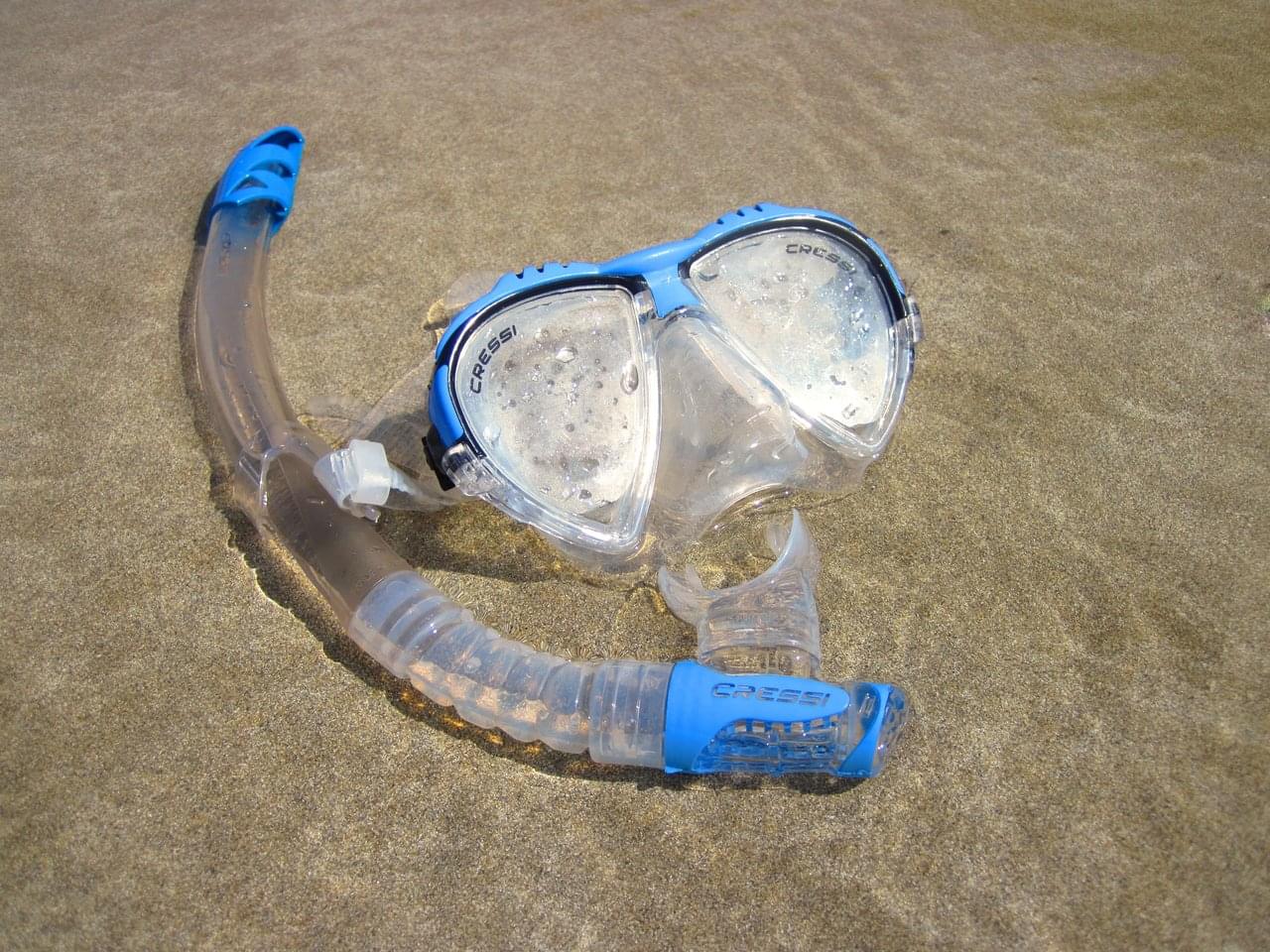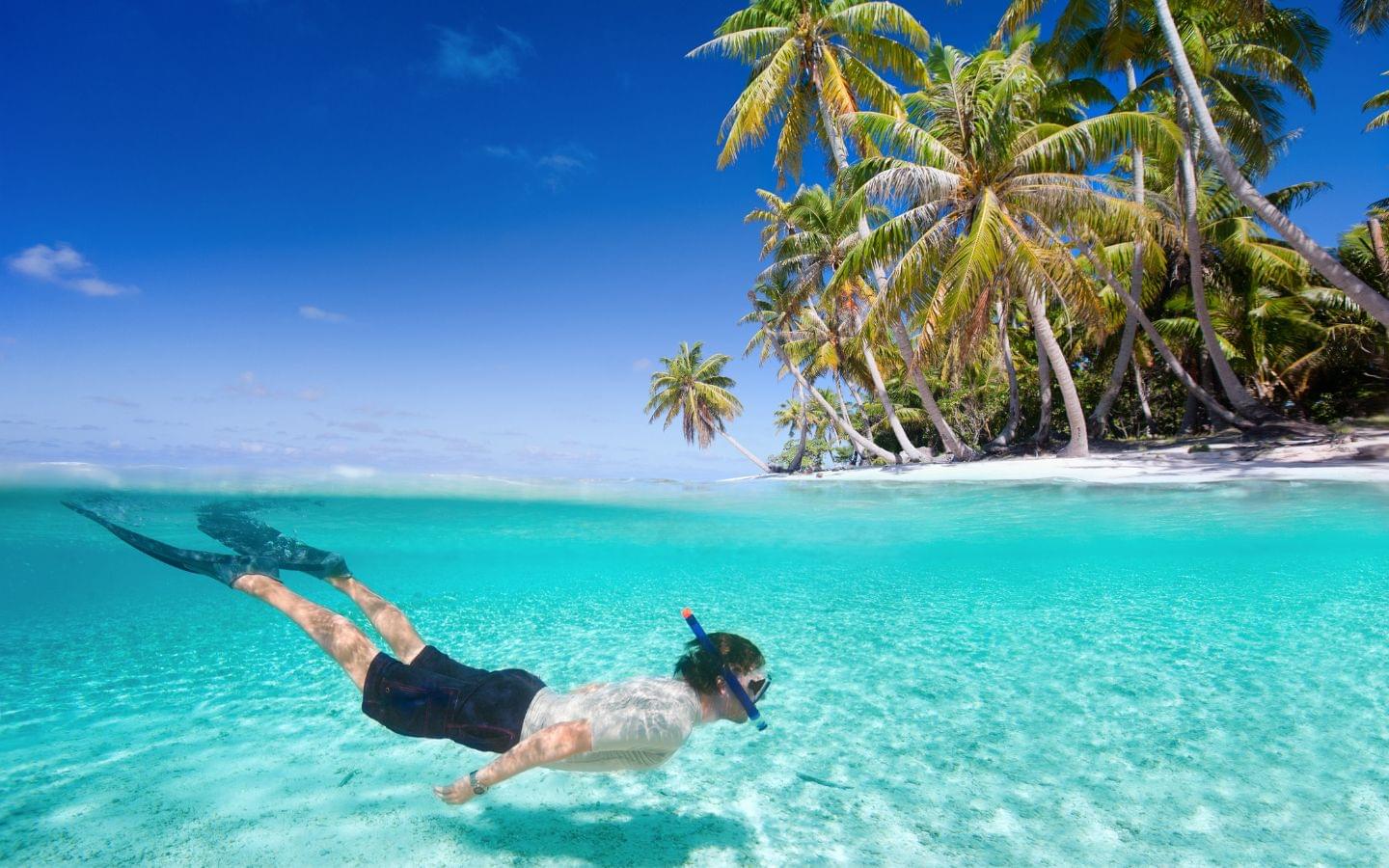What is a dry snorkel and how does it work?
Snorkels may all look similar to the untrained eye, but there are several different types: dry snorkels, semi-dry snorkels, and wet snorkels. Each type has various features that make it a better choice for certain people and activities.
A dry snorkel, or dry-top snorkel, is the only kind designed to keep water from entering the breathing tube when submerged and is the best option for beginners.
Dry snorkels achieve this effect through a mechanism called a float valve located near the opening of the tube. The valve seals if the snorkel is submerged in water, which could happen in wavy conditions or if a snorkeler dives under the surface. This feature is especially useful for new snorkelers since it helps them avoid swallowing water.
If you’re wondering whether a dry snorkel is right for you, you’re in the right place. Below, we’ll cover how dry snorkels work and explain how they differ from other types of snorkels. We’ll also weigh their advantages and disadvantages and recommend a top product for those who are ready to invest in a dry snorkel of their own.

Parts of a dry snorkel
Before we get into the details of how a dry snorkel works, let’s go over the features you can expect to find on this type of snorkel:
- Float valve: This is the distinguishing feature of dry snorkels. The float valve, also known as a dry valve, is located at the top of the tube and seals when the snorkel is submerged to block water from entering.
- Splash guard: Since the float valve only closes when the snorkel is underwater, dry snorkels also come equipped with a plastic splash guard at the top of the tube to prevent water from getting inside while at the surface. This could happen as a result of waves, splashing from nearby swimmers, or your own movement in the water.
- Tube: The tube is the main part of the snorkel where air exchange occurs.
- Flex tube: On many dry snorkels, the bottom of the tube is made of a flexible material like silicone to provide a more adjustable and comfortable fit and reduce jaw fatigue. This feature also allows the mouthpiece to fall away when not in use, so it won’t get in your way when you take a break from snorkeling.
- Mask clip: Nearly all snorkels have a small clip on the tube to attach the snorkel to your mask strap. Some models have a quick-release clip, which includes a mechanism to detach the mask from the snorkel easily, and a swivel attachment for additional mounting versatility.
- Mouthpiece: The best dry snorkels will have a soft silicone mouthpiece for a comfortable fit even after hours of use.
- Reservoir: Below the mouthpiece is a small area called a reservoir where any water that gets into the snorkel will collect.
- One-way purge valve: Located at the bottom of the snorkel, this valve allows users to conveniently purge any water that does happen to enter the breathing tube. Without a purge valve, snorkelers must clear water out through the top of the snorkel, a technique that requires additional experience and lung power.
How does a dry snorkel work?
The float valve mechanism on dry snorkels is designed to seal only when the snorkel is completely underwater. To make this work, the top contains a float that is made of a buoyant material and attached to a hinge valve.
When the snorkel is submerged, the float will rise and shut the valve at the top of the tube, thereby preventing any water from getting inside. Snorkelers can still breathe out through the tube of a dry snorkel while underwater if they wish to clear their lungs.
Once the top of the snorkel is back above the surface of the water, the float mechanism will sink down and open the valve, allowing the user to breathe normally through the snorkel.

How is a dry snorkel different from other types of snorkels?
Other than the float valve, dry-top snorkels and semi-dry snorkels have many of the same features for added comfort and ease of use, making them better for beginners. Wet snorkels, on the other hand, have a much more minimalist design and are best for experienced snorkelers.
Dry-top snorkel
Dry snorkels are the only type of snorkel that prevents water from entering the tube when submerged and are the best option for beginners. Any water that does happen to get inside can easily be cleared through the purge valve. Dry snorkels are available in a classic tube design or as full-face snorkel masks.

Semi-dry snorkel
Semi-dry snorkels have many of the same features as dry snorkels, including a splash guard and purge valve. However, they lack the float valve that characterizes dry snorkels and therefore do not block water from entering the tube when entirely submerged. This makes semi-dry snorkels less ideal for total beginners, but better for snorkelers who plan on diving underwater to get closer to marine life.
The best semi-dry snorkels offer a balance between comfort and function, making them the most versatile of all types of snorkels.
Wet snorkel
Wet snorkels are the most basic and do not have any mechanisms that prevent the snorkel tube from filling with water. These classic snorkels most often consist only of a soft silicone mouthpiece, a small reservoir, a j-shaped tube, and a mask clip. Because of their minimalist design, this type of snorkel is popular among freedivers and spearfishers.
Sometimes wet snorkels have a purge valve and flexible tube, but these features more commonly appear on semi-dry snorkels and dry-top snorkels.

Benefits of using a dry snorkel
The main benefit of a dry snorkel is minimizing the amount of water that ends up in the breathing tube. Using a dry snorkel is therefore one of the best ways that beginners can avoid swallowing water while snorkeling until they become more comfortable with proper techniques.
Even if you’ve been snorkeling before, you may struggle to clear water from the tube and find it simpler and more relaxing to use a dry snorkel. If you plan on staying near the water’s surface and are looking for a low-key snorkeling experience, a dry snorkel is an excellent option.
Disadvantages of using a dry snorkel
While dry snorkels have a clear advantage for newcomers and snorkeling only at the surface, they are not ideal for activities where you’ll be spending a lot of time underwater, including freediving, spearfishing, and scuba diving.
Since the float valve seals when the snorkel is completely submerged, it traps air inside the tube. This air creates unwanted buoyancy and drag underwater, making it more difficult to dive. As a result, freedivers, spearfishers, and scuba divers often prefer semi-dry snorkels or classic snorkels.
The increased buoyancy can also pull on the mask, which some users find annoying.
Dry snorkels also tend to be wider and bulkier than other types. Depending on the model you choose, air exchange in dry snorkels may be more challenging than classic snorkels.
Longer, thicker snorkels have more respiratory dead space than shorter ones, resulting in higher concentrations of carbon dioxide in the breathing tube.1 The longer and wider your snorkel is, the more work your lungs will have to do to fully exchange the air.
If you are a smaller person with lower lung capacity, you’ll want to be sure to select a snorkel with less volume to facilitate proper air exchange. No matter which type of snorkel you choose, it should be a maximum of 15 inches or 38 centimeters in length for those with larger lung capacity and a maximum of 13.8 inches or 35 centimeters for those with smaller lung capacity.2
We recommend: Cressi Supernova Dry Snorkel
Overview:
The Cressi Supernova Dry Snorkel is a high-quality piece of snorkeling gear that won’t break the bank. The float mechanism closes quickly the moment the snorkel is submerged to help keep you from swallowing water, and there are many features for enhanced comfort.
Some users cautioned that the float valve is vulnerable to sand and may become jammed in sandy water. Simple snorkel gear care and maintenance should help prevent this from occurring (read our article on cleaning best practices here).
Overall, the Cressi Supernova Dry Snorkel has excellent product reviews and provides fantastic value for money.
Snorkel features:
- Wider bore shape inside the tube boosts airflow capacity for easier breathing
- Comfortable mouthpiece is replaceable and made of soft, durable silicone
- Quick-release snorkel keeper
- Effective splash guard for extra protection
- Ergonomic, contoured shape for added comfort


Cressi Supernova Dry Snorkel
High-quality piece of snorkeling gear that won’t break the bank.
Check PriceConclusion
Dry snorkels have clear advantages for anyone new to snorkeling but are not the best choice for those who plan on diving underwater. Whether or not a dry snorkel is right for you will depend on your snorkeling experience, intended use, and level of comfort with clearing water from the tube.
References
-
Toklu, A. S. et al. (2003). Ventilatory and metabolic response to rebreathing the expired air in the snorkel. International journal of sports medicine, 24(3), 162–165. doi:10.1055/s-2003-39084 ↩
-
British Standards Institution: BS EN 1972: Diving equipment - Snorkels - Requirements and test methods, London: British Standards Institution, 2015. bsigroup.com. ↩
Last updated 17 October 2024




